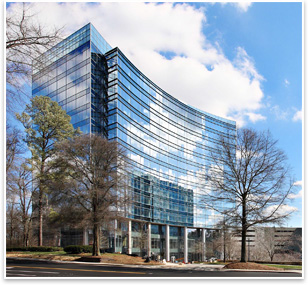 GBI and AIA Team Up to Promote Sustainable Buildings GBI and AIA Team Up to Promote Sustainable Buildings
Summary: The Green Building Initiative (GBI) and the AIA have signed a memorandum of understanding pledging to work together to promote the design and construction of energy efficient and environmentally responsible buildings.
Newell Rubbermaid Headquarters in Atlanta. Designed by Perkins + Will, and certified with two Green Globes. Image courtesy of the GBI.
Ward Hubbell, president of the GBI, praised the AIA’s knowledge and experience in helping to develop the Green Globes system. “We are happy to have this agreement in place,” he said. “The AIA’s support and expertise in the development of the Green Globes Standard, through participation on the ANSI Technical Committee, has been invaluable. We look forward to continuing our work with them towards our shared goal of achieving widespread acceptance of sustainable design and construction practices.”
AIA Executive Vice President/CEO Chris McEntee said that she looks forward to the AIA and GBI together tackling the goal of carbon neutrality by 2030. “The GBI’s engagement in life cycle assessment and promotion of post-construction third-party review in Green Globes illustrates GBI’s commitment to the creation of high-performance buildings and supports the role of the architect in creating them,” she said.
This agreement calls for the two organizations to:
- Promote the design of buildings that are energy-efficient, healthier, and environmentally responsible by providing education and training
- Offer educational opportunities that include content on LCA, Green Globes New Construction (GGNC), and Green Globes Continual Improvement of Existing Buildings (GGCIEB)
- Encourage or undertake research to identify strategies for specific economic and environmental performance outcomes for green buildings.
Green Globes
In 2004, the GBI acquired the Green Globes system, which began as environmental rating system developed in Canada. It assigns sustainability ratings along a 1,000-point checklist. One Green Globe is the lowest score, four Green Globes is the highest score. Categories the system evaluates are energy, indoor environment, emissions and effluents, resources, environmental management, and water. Over one third of these points focus on energy efficiency. Green Globes users get their ratings by filling out a Web-based list of 150 questions about their design. This tool is designed to be easy to use and approachable in the hopes of attracting architects and builders who might be intimidated by more technical, unwieldy systems.
The Green Globes rating system uses Department of Energy data on how much energy actual, standard buildings consume. This system contrasts how this building efficiency baseline compares to a new, more sustainable design. In a progressive step towards full-building life-cycle energy modeling, this baseline energy performance data can then be compared to results from the Green Globes Life Cycle Assessment (LCA) Credit Calculator, which analyzes a proposed design’s energy performance characteristics over time. Also built into the online questionnaire, the LCA tool predicts the performance of hundreds of building assemblies and takes into account many other variables that affect a building’s performance: materials, embodied energy, solid waste, air and water pollution, and global warming potential.
Approximately 700 buildings in Canada and 55 in the United States have been Green Globes certified.
The mission of the Green Building Initiative is to accelerate the adoption of building practices that result in energy-efficient, healthier, and environmentally sustainable buildings by promoting credible and practical green building approaches. A not-for-profit education initiative, the GBI is supported by a broad cross section of organizations and individuals with an interest in residential and commercial construction.
|



